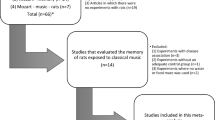Abstract
Classically conditioned locomotor activity has been demonstrated by pairing injections of dopamine agonists or antagonists with specific environmental stimuli. The present studies investigated conditioning using drugs with varying selectivity for the dopamine D1 or D2 receptor. Experiment 1 assessed conditioning in groups of rats using the indirect acting agonist (+)-amphetamine (2.0 mg/kg), and the D1 agonist SKF 38393 (10.0 mg/kg), the D2 agonist quinpirole (2.5 mg/kg), the D1 and D2 antagonists, SCH 23390 (0.05 mg/kg) and metoclopramide (25.0 mg/kg), respectively. Paired groups received nine 2-h drug-environment (automated activity monitoring chambers) pairings whereas Unpaired groups received the stimuli explicitly unpaired. Test revealed conditioned hyperactivity with each agonist and metoclopramide whereas conditioned hypoactivity was seen with SCH 23390. Experiment 2 assessed the interaction of these agonists and antagonists on the establishment of conditioned activity. Paired groups received an agonist and antagonist during conditioning sessions. SCH 23390 blocked conditioning based on (+)-amphetamine and SKF 38393 but not quinpirole. Metoclopramide (10.0 mg/kg) blocked conditioning based on quinpirole but not SKF 38393. Metoclopramide (25.0 mg/kg) also did not block (+)-amphetamine-induced conditioning. These studies suggested that drug-induced alterations at either D1 or D2 receptors may be involved in conditioned locomotion.
Similar content being viewed by others
References
Barr GA, Sharpless NS, Cooper S, Schiff SR, Paredes W, Bridger WH (1983) Classical conditioning, decay and extinction of cocaine-induced hyperactivity and stereotypy. Life Sci 33:1341–1351
Beninger RJ (1983) The role of dopamine in locomotor activity and learning. Brain Res Rev 6:173–196
Beninger RJ, Hahn BL (1983) Pimozide blocks the establishment but not expression of amphetamine-produced environment-specific conditioning. Science 220:1304–1306
Beninger RJ, Herz RS (1986) Pimozide blocks establishment but not expression of cocaine-produced environment-specific conditioning. Life Sci 38:1425–1431
Beninger RJ, Cooper TA, Mazurski EJ (1985) Automating the measurement of locomotor activity. Neurobehav Toxicol Teratol 7:79–85
Beninger RJ, Hoffman DC, Mazurski EJ (1989) Receptor subtype-specific dopaminergic agents and conditioned behavior. Neurosci Biobehav Rev 13:113–122
Clark D, White FJ (1987) Review: D1 dopamine receptor: the search for a function: a critical evaluation of the D1/D2 dopamine receptor classification and its functional implications. Synapse 1:347–388
deGraaf CJ, Korf J (1986) Conditional tolerance to haloperidol-induced catalepsy is not caused by striatal dopamine receptor supersensitivity. Psychopharmacology 90:54–57
Herz RS, Beninger RJ (1987) Comparison of the ability of (+)-amphetamine and caffeine to produce environment-specific conditioning. Psychopharmacology 92:365–370
Kebabian JW, Calne DB (1979) Multiple receptors for dopamine. Nature 277:93–96
Keppel G (1973) Design and analysis: a researcher's handbook. Prentice-Hall, Engelwood Cliffs, NJ
Lyon M, Robbins TW (1975) The action of central nervous system stimulating drugs: A general theory concerning amphetamine effects. In: Essman W, Valzelli L (eds) Current developments in psychopharmacology, vol 2. Spectrum, New York, pp 79–163
Mazurski EJ, Beninger RJ (1987) Environment-specific conditioning and sensitization with (+)-amphetamine. Pharmacol Biochem Behav 27:61–65
Mazurski EJ, Beninger RJ (1988) The dopamine D-2 agonist quinpirole produces environment-specific conditioned activity. Pharmacol Biochem Behav 30:525–527
Miller R, Wickens J, Beninger RJ (1990) Dopamine D-1 and D-2 receptors in relation to reward and performance: a case for the D-1 receptor as a primary site of therapeutic action of neuroleptic drugs. Prog Neurobiol 34:143–183
Moller H-G, Nowak K, Kuschinsky A (1987) Conditioning of pre- and post-synaptic behavioural responses to the dopamine receptor agonist apomorphine in rats. Psychopharmacology 91:50–55
Pickens RW, Crowder WF (1967) Effects of CS-US interval on conditioning of drug response, with an assessment of speed of conditioning. Psychopharmacologia 11:88–94
Poncelet M, Dangoumau L, Soubrié P, Simon P (1987) Effects of neuroleptic drugs, clonidine and lithium on the expression of conditioned behavioral excitation in rats. Psychopharmacology 92:393–397
Post RM, Rubinow DR, Ballenger JC (1984) Conditioning, sensitization, and kindling: Implications for the course of affective illness. In: Post RM, Ballenger JC (eds) Neurobiology of mood disorders. Williams and Wilkins, Baltimore, pp 432–466
Poulos CX, Hinson R (1982) Pavlovian conditional tolerance to haloperidol catalepsy: evidence of dynamic adaptation in the dopaminergic system. Science 218:491–492
Robinson TE, Becker JB (1986) Enduring changes in brain and behavior produced by chronic amphetamine administration: a review and evaluation of animal models of amphetamine psychosis. Brain Res Rev 11:157–198
Schiff SR (1982) Conditioned dopaminergic activity. Biol Psychiatry 17:135–154
Stoof, JC, Verheijden PFHM (1986) D-2 receptor stimulation inhibits cyclic AMP formation brought about by D-1 receptor stimulation in rat neostraitum but not nucleus accumbens. Eur J Pharmacol 129:205–206
Tilson HA, Rech RH (1973) Conditioned drug effects and absence of tolerance tod-amphetamine induced motor activity. Pharmacol Biochem Behav 1:149–153
Author information
Authors and Affiliations
Rights and permissions
About this article
Cite this article
Mazurski, E.J., Beninger, R.J. Effects of selective drugs for dopaminergic D1 and D2 receptors on conditioned locomotion in rats. Psychopharmacology 105, 107–112 (1991). https://doi.org/10.1007/BF02316871
Received:
Revised:
Issue Date:
DOI: https://doi.org/10.1007/BF02316871




